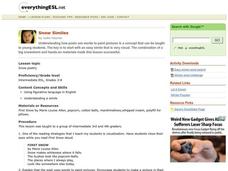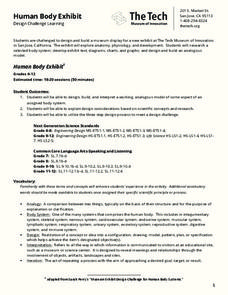Curated OER
Metaphors
In this metaphor worksheet, students make a "word card" with the word metaphor for their vocabulary bank, then determine whether statement from The Dragonslayer are similes or metaphors,
Curated OER
Investigating Quadrilaterals
Fourth graders discuss the various attributes of quadrilaterals. In groups, they use the attributes to sort quadrilaterals into different classes and a hierarchy. They review the new vocabulary and attributes with a partner to end the...
Curated OER
National Sterotypes
Students develop their own ideas about the world around them. This lesson helps them improve their descriptive adjective vocabulary while they discuss perceived differences between nations through stereotypes.
Curated OER
Japanese Culture
Seventh graders make connections with the history of Japanese art with the modern use of ancient warriors in the popular Yu-Gi-Oh trading cards. They journal and reflect upon the research and comparison of the ancient to modern art.
Curated OER
Singing Lesson for Grades 5-8
Students practice their breath control and posture in this singing lesson. They sing with accurate pitch and rhythm. They sing the songs repeatedly while evaluating their breathing ability in small groups and then regroup as a class to...
Curated OER
The Raven
After a close reading of Edgar Allan Poe's "The Raven" individuals copy the rhythm and rhyme scheme and rewrite the final stanzas of the poem.
Curated OER
Canada - US: Approaches to Immigration
Sixth graders explore the Canadian immigration experience through comparison and contrast to American immigration and settlement patterns. In this immigration patterns lesson, 6th graders dialogue their opinions regarding immigration....
Curated OER
Ancient History
Students investigate the concept of water usage and conservation. The differences between modern and ancient practices are considered. They conduct research into the economic and social characteristics of ancient civilizations like Egypt...
Curated OER
Making Cents of Independence
Students explore the causes and major events of the Texan and American revolutions. Comparisons and contrasts are made between the two revolutionary experiences and applied to the symbolism used on the Texas State quarter.
Curated OER
Snow Similes
Students see how poets use words to paint pictures. The combination of a big snowstorm and hands-on materials make this lesson successful. There are some nice attachments that the students will really enjoy!
Curated OER
Worms and more
Students have early length experiences must develop an awareness of what length is, and of the range of words that can be used to discuss length. Young children usually begin by describing the size of objects as big and small. They...
Curated OER
New Year Celebrations in Korea
Students investigate the New Year's holiday looking at the American tradition in comparison to Korea. This helps to point out the qualities of the holiday for those who live in Korea.
Curated OER
Making Connection, Using Metaphor
Chief Seatle's "Letter to President Pierce, 1855" provides the text for a skills exercise that asks readers to consider how writers use metaphors to contribute to the meaning and impact of a work. Participants then apply what they have...
Tech Museum of Innovation
Human Body Exhibit
Explore human anatomy and physiology using models. Scholars study systems of the human body and design a display for a museum exhibit. To complete the activity, individuals create analogous models of their chosen human body systems.
Curated OER
Freak the Mighty: Chapter 18 Semantic Feature Analysis
Intelligent? Arrogant? Obnoxious? After completing Chapter 18 of Freak the Mighty, individuals fill out a semantic feature chart for characters in Rodman Philbrick's novel. Group members then use their charts to discuss relationships...
Curated OER
Can You Figure Language?
Eighth graders study similes and metaphors and how to explain and create them. After a lecture/demo, 8th graders access websites and worksheets imbedded in this plan to create their own writing.
Curated OER
In Case of a Medical Emergency
Studens identify the variety of services available to them at their local medical facilities. In pairs, they role play different conversations that can take place during a medical emergency. High schoolers create a brief description of...
Curated OER
Making It Balance
Students listen to story, "The 100-Pound Problem," compare their weight with character in story, and weigh different classroom items using nonstandard units and standard units. They experiment with different items that can make scale...
Curated OER
Painted Dreams
Third graders explore the importance of art in Haitian culture by analyzing the cause and effect within the story, "Allie's Basketball Dream." They examine all the aspects of the story and characters including their goals, dreams,...
Curated OER
A New Phase In Town
Middle schoolers explore heat energy and how it is used to change the phase of matter, and discover that temperature does not increase or decrease until the phase change is complete. This extremely well-written plan is packed with great...
For the Teachers
Cause and Effect Matrix
Study cause and effect in both literature and informational text with a lesson designed for several different reading levels. After kids review the concept of cause and effect, they read an article or story and note the causes and...
Ohio Department of Education
A Glossary of Literary Terms
If you're tired of defining allusion, onomatopoeia, and satire for your language arts students, hand out a complete list of literary devices to keep the terms straight. Each term includes a definition that is easy to understand and...
Learning to Give
Your Place in the Community
Learners identify their beliefs and values and compare how these values relate to those of their community. They then determine how their values affect the roles they play in different situations. A quiz about values and beliefs...
Virginia Department of Education
Field Goals, Balls, and Nets
Score a resource on ratios. Young mathematicians learn about different ways to express ratios. Using sports data, they write statements about the statistics in ratio form.

























